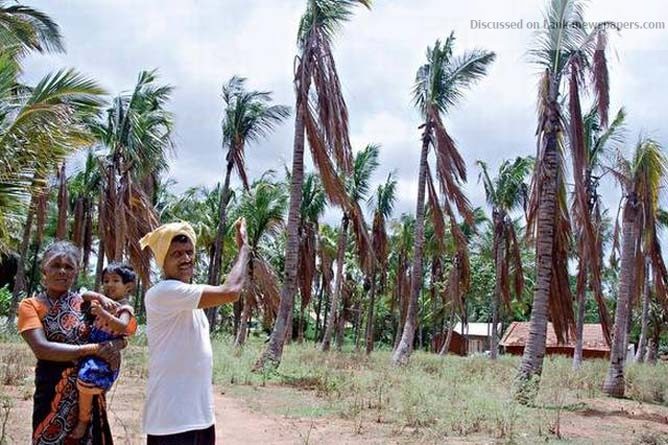No joy from rains for coconut growers, suffering farmers in five districts
More than 280,000 people, including farmer families, who are suffering due to the drought in five districts Puttalam, Kurunegala, Mannar, Anuradhapura, and Polonnaruwa, will not be able to expect relief until at least the April inter-monsoonal rains, the weather forecasters say.

The unprecedented drought also spells danger for the coconut industry in two leading growing areas Kurunegala and Puttalam. Industry insiders had estimated at least 240 days of drought in 2016 alone. In that year, they say, Kurunegala, Puttalam and Gampaha received an aggregate total of two inches of rain. A mite infestation is making things worse.
The duty meteorologist of the Department of Meteorology, said that in the five districts that have been severely affected by drought, a small amount of rain will not be enough to help farmers. But April rains could help.
As for the prevailing heat, he said it was normal, but that low wind speeds ahead of the inter-monsoon rains, is also a factor.
Deputy director and media spokesman of the Disaster Management Centre, Pradeep Kodippili, told the Sunday Times that the five districts are facing dry conditions and not drought.
According to him, water is being distributed and a drought relief plan will be implement after assessing the future weather.
According to the DMC, 288,193 people and 90,381 families have been badly affected by the drought. It says that 216,018 people are suffering in the Puttalam District, followed by Kurunegala District with 50,918 people badly affected.
In Mannar District, 10,612 people are suffering and 9,655 need help in Anuradhapura District reported. In Polonnaruwa District, 990 people are suffering.
The director of irrigation water management and training, W B Palugaswewa, said farmers in Mannar, Vavuniya, Puttalam and Kurunegala can not get involved in large-scale cultivation.
“The new concept we promote is the maximum use of rain water and a small fraction of tank water. This was implemented in the Ampara District and about 120,000 acres were cultivated,’’ he said.
However, according to him, this concept cannot be practised everywhere due to the fluctuation in the rainfall.
He suggested using groundwater resources for cultivation.
“According to our forecast, Sri Lanka can expect drought conditions until 2020 and it will ease after that,’’ he said.
Kurunegala farmer Sanjeewa Karunasagra, said five seasons had not been cultivated over two years. Farmers are deep in debt. Some farmers have switched to coconut cultivation but production has dropped.
T. B. Sarath, the secretary of the All-Island Farmers Federation of Polonnaruwa, said 50% to 70% of paddy land was cultivated in the past growing seasons and this was enough to meet the country’s demand of 2.8 million metric tonnes of paddy.
But now less than 2 million metric tonnes of paddy were available, which has also resulted in rising prices.
| PADDY PRODUCTION NEARLY HALVED | |
| The severe drought is slowly but surely squeezing the life out of Sri Lanka’s rice production, suggesting that prices could rise further and imports will have to increase. Last year Sri Lanka’s rice output was nearly half of that in 2016, a UN organisation estimates, citing official data.The aggregate rice output is estimated at 2.5 million tonnes, or 1.7 million tonnes, on a milled basis, 43% less than the output in 2016 and 41% lower than the average of the previous five years, the Food and Agriculture Organization has estimated. This decline is attributed to the severe droughts at the end of 2016 and early 2017. Other cereals, including maize, various pulses, chillies and onions, mainly grown under rain-fed conditions, were also heavily damaged by the dry weather, the FAO says. This year, the main season, Maha paddy output is expected to partially recover from last year’s severely reduced level but still be below average, the FAO warns. Planting for the 2018 main season surpassed last year’s drought-reduced level, but it still it lagged well behind normal years, the FAO says. |

